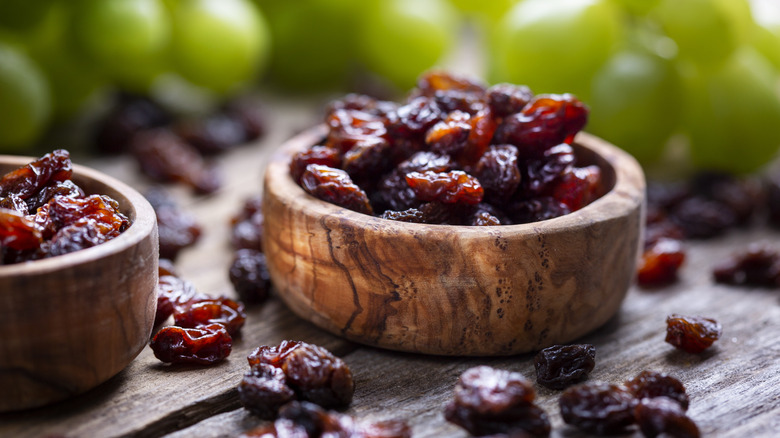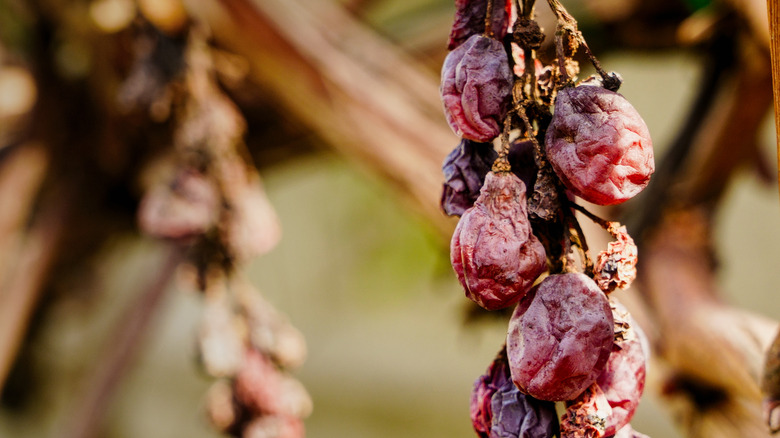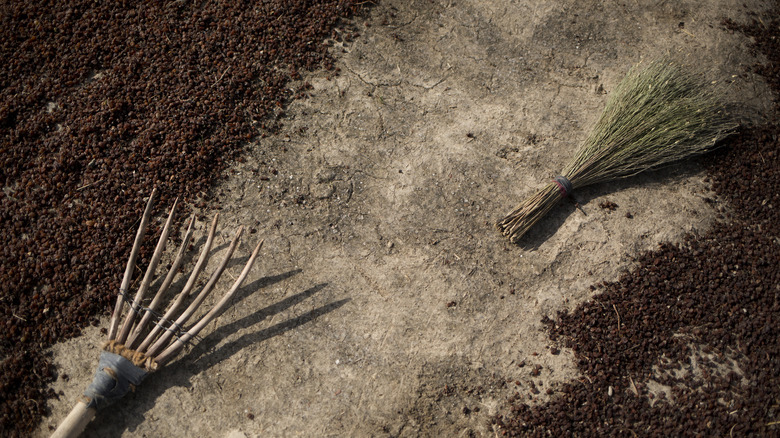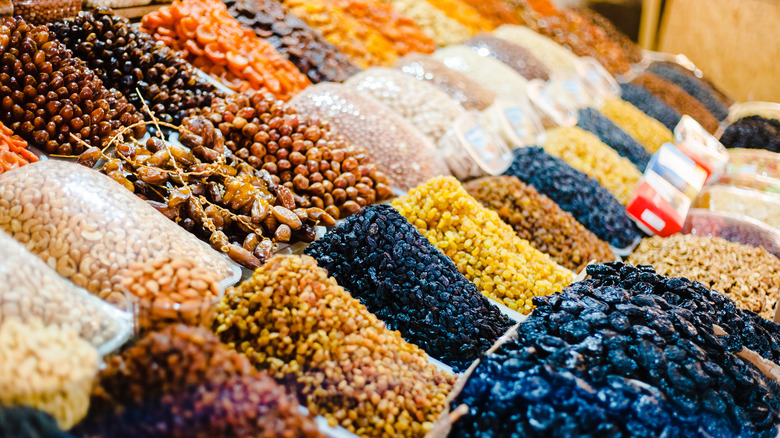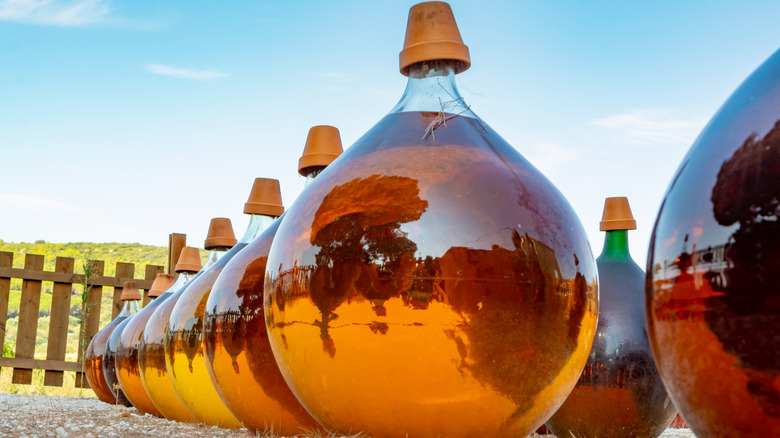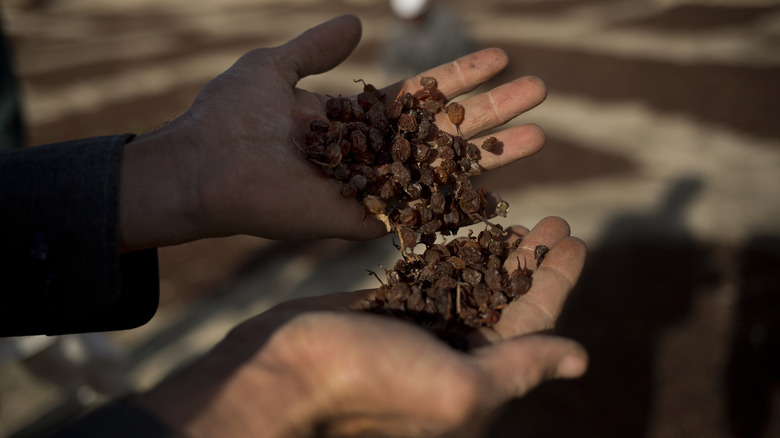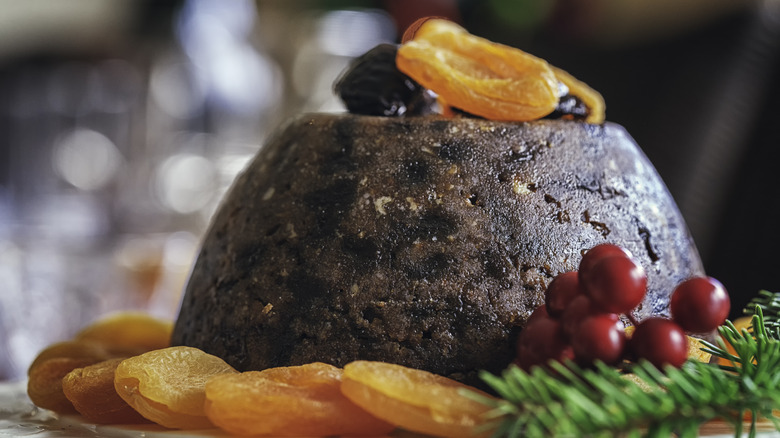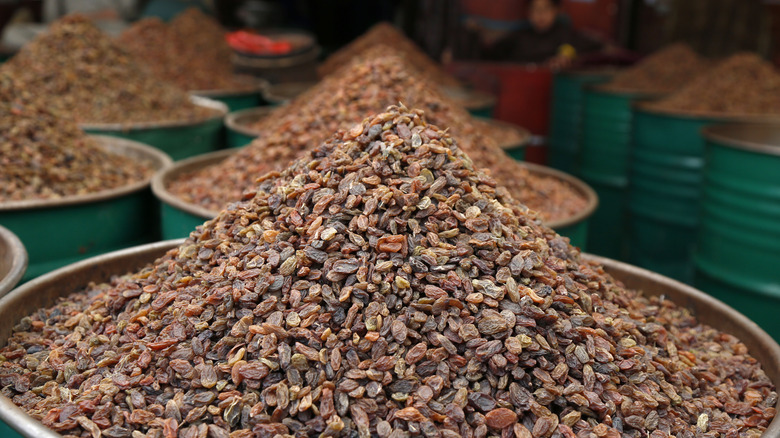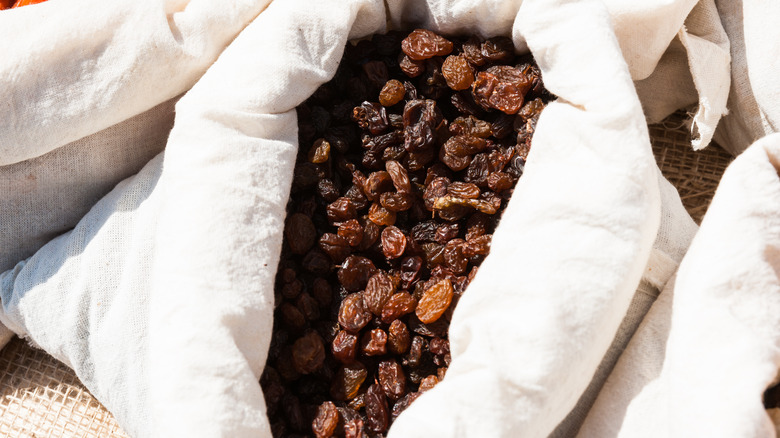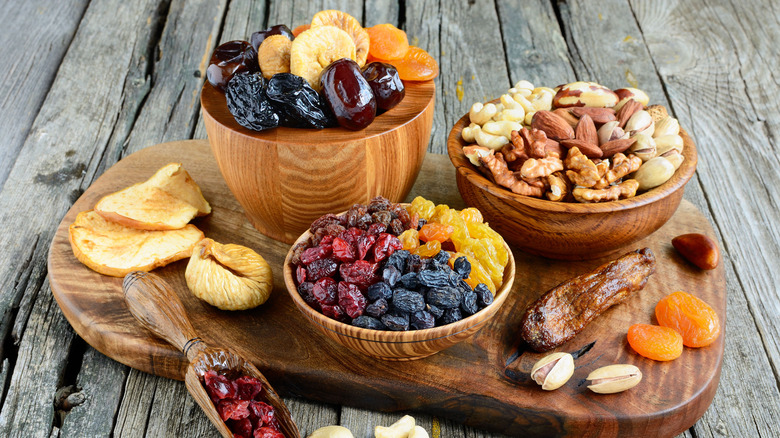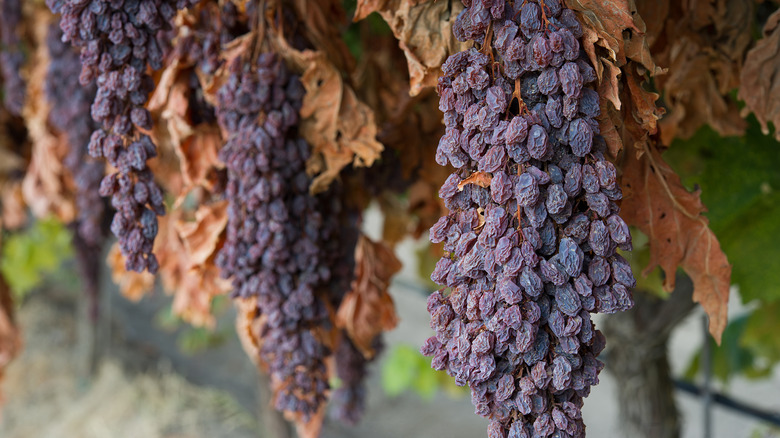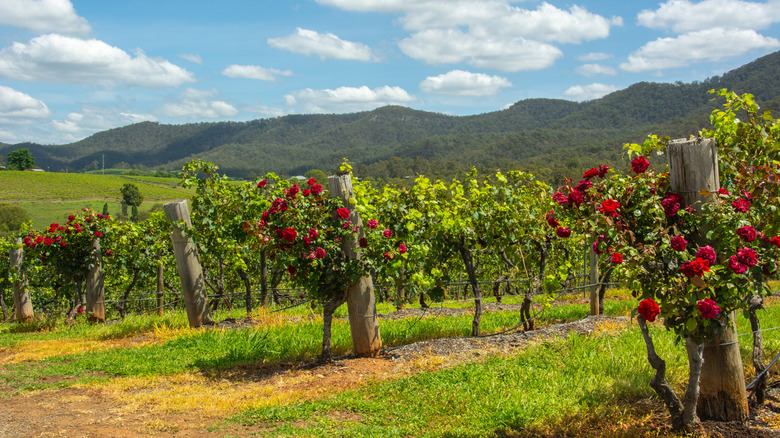The Untold History Of Raisins
You probably eat raisins without a second thought to their origins, but these sweet treats date back thousands of years. The history of raisins is a captivating journey that traverses centuries, cultures, and culinary evolution. While often overlooked in the shadow of more glamorous fruits, the unassuming raisin has a storied past that weaves together tales of ancient civilizations, trade routes, and gastronomic innovations.
A product of the sun's alchemy, raisins were treasured in the ancient world not only for their sweet flavor, but also for their ability to withstand the test of time without spoiling. As we delve deeper into the annals of history, we discover how raisins traveled the world and found their way into the kitchens of various civilizations across the globe. While raisins gained popularity as a snack and natural sweetener, their impact transcended the culinary realm. From ancient rituals and offerings to the gods to religious ceremonies, raisins became woven into the fabric of cultural practices, rites, and traditions.
As we journey through the ages, we unveil the transformative role of raisins in the evolution of cuisine. From ancient Rome to medieval feasts to kids' lunchboxes, raisins have consistently adapted to changing tastes and culinary advancements. So, let's delve into the untold history of raisins, and learn more about how these dried fruits made it from the ancient world right through to the 21st century.
The first raisins were grown as long ago as 2,000 B.C.
The cultivation of raisins dates back thousands of years to ancient civilizations. You can trace the first recorded instances of raisin production to the ancient region of Persia, which is now modern-day Iran, as well as to ancient Egypt. The warm, arid climate of these nations provided the perfect conditions for drying grapes naturally, giving rise to the earliest form of raisins.
Historical accounts suggest that raisin production in Persia and Egypt dates as far back as 2000 B.C. While these historical records of ancient raisin cultivation are somewhat limited, there are references and writings from various sources that provide insights into the cultivation of grapes and the production of raisins in the region. These include archaeological findings, such as pottery and wall reliefs, that depict scenes of grape production. There were also Greek and Roman historians and writers, such as Herodotus and Pliny the Elder, who mentioned the cultivation of grapes and the production of dried fruits in Persia and Egypt. People probably discovered raisins by accident when grapes were left on the vine and dried naturally. However, this discovery — although accidental — was revolutionary. It let grapes be preserved and consumed long after the harvest season had passed.
The ancient Romans were big fans of raisins
Raisins were significant in the culinary and cultural landscape of ancient Rome. These delicious dried fruits were cherished for their sweetness, versatility, and long shelf life. Sure, grapes were consumed fresh and enjoyed as a popular fruit, as well, but the art of drying grapes to create raisins was common in Roman society. This process not only preserved the fruit, but also concentrated its flavors.
In ancient Rome, raisins were not only savored as a snack, but also incorporated into a wide array of dishes. They lent their sweetness to both sweet and savory recipes, adding a unique depth of flavor to various meals. Raisins were used in cooking sauces, stews, and even in the stuffing of meats, reflecting the Romans' penchant for intricate and flavorful cuisine.
Raisins were not limited to the culinary realm; they also played a role in Roman religious and cultural practices. In offerings to the gods and during religious ceremonies, raisins were presented as a symbol of abundance and a connection to the earth's bounty. Their presence in religious rituals showcased their cultural significance. The Romans' fascination with raisins is also evident in their literature and writings. You can find references to raisins in the works of ancient Roman authors such as Pliny the Elder, who wrote extensively about the cultivation of grapes and the production of dried fruits. These writings show how much ancient Romans cared about raisins.
Raisins were also huge in ancient Greece
You could hardly throw a stone in ancient Greece without it landing in a pile of raisins. These dried fruits were a hit with ancient Greeks for their natural sweetness, versatility, and nutritional value. The cultivation and consumption of grapes and their transformation into raisins held a place of importance in Greek society, leaving an indelible mark on the gastronomic and historical landscape.
The process of drying grapes to create raisins was well-known to the ancient Greeks. This practice lets people keep grapes for longer, providing a valuable source of sustenance and flavor throughout the year. Raisins were used as a snack, a sweetener, and an ingredient in various dishes, reflecting the Greeks' culinary ingenuity.
Raisins found their way into many recipes in ancient Greek cuisine. People used them in both savory and sweet dishes, adding depth and complexity to the flavors. But, beyond their culinary uses, raisins held cultural and symbolic significance. They were often offered to the gods in religious rituals and ceremonies as a gesture of reverence and gratitude. This practice underscored the Greeks' belief in the divine connection between the fruits of the earth and the deities they worshiped. Raisins also showed up in Greek literature and mythology. In ancient writings, such as the works of poets like Homer, raisins were mentioned as offerings to heroes and deities. These references provide insights into the role of raisins in both everyday life and the spiritual practices of the time.
Women in ancient Rome drank a raisin-based drink instead of wine
You might think of the wine flowing in ancient Rome with people consuming it in vast quantities at feasts or even just at the dinner table. And, while this might have been true for some, it certainly wasn't for women. You see, in ancient Rome, it was generally considered immoral for women to drink, as it was thought to lead to vice. Women could even be punished for drinking wine. However, there were some acceptable types of alcohol for women to drink, one of them being passum — a type of alcohol made from raisins.
Passum was produced by allowing grapes to dry on the vine or in the sun, concentrating their sugars and flavors. The resulting raisins were then turned into wine. This drink wasn't just enjoyed by women. It generally held a special place in Roman culture and was particularly associated with rituals, religious ceremonies, and social gatherings. It was often used as an offering to the gods in religious rituals and feasts. The consumption of passum was believed to symbolize abundance, fertility, and prosperity, making it a fitting tribute to the deities and an integral part of various religious practices. More than just a drink, passum was a cultural artifact that played a part in religious observances, social customs, and traditions in ancient Rome. It's an example of the intricate interplay between food, drink, and society in the rich tapestry of Roman life.
Raisins featured in the oldest surviving cookbook
You've probably got a range of cookbooks, but have you ever thought about what the first ever recipe book was? Well, the oldest surviving collection of recipes was written by Marcus Gavius Apicius, an influential figure in the ancient Roman culinary scene. This groundbreaking compilation, simply titled "Apicius," has left an indelible mark on the history of cooking, and continues to captivate the imaginations of modern food enthusiasts. Another fun fact — it features lots of dishes that contain raisins.
"Apicius" is believed to have been compiled in the 4th or 5th century A.D. and is not only a collection of recipes, but also a comprehensive guide to the culinary arts of its time. Divided into several volumes, this ancient cookbook covers a wide range of dishes, techniques, and ingredients, providing insights into the diverse flavors and culinary practices of the Roman Empire.
"But, what about the raisins?" we hear you cry. Well, raisins and raisin wine feature in many of Apicus' recipes, including many sauces. One such sauce contains pepper, thyme, cumin, celery seed, fennel, rue, mint, myrtle berries, raisins, raisin wine, and mead to taste. Another dish involves roasting a hare before sprinkling it with a number of ingredients, including dates and raisins. You might not see any of these recipes on the menu of your local Olive Garden any time soon, but this is truly old-school Italian fare.
Raisins didn't make it to Northern Europe until the 11th century
The 11th century was a pivotal era for raisins when they finally made it to Northern Europe. This journey was intertwined with the epic voyages of knights returning from the Crusades. You see, back in the 11th century, many knights embarked on quests that today we'd consider ill-advised. The aim of these quests was to "reclaim" the Holy Land, driven by religious fervor.
Little did these knights know that their travels would lead to the introduction of new flavors and ingredients to their homelands, forever altering the culinary landscape of Northern Europe. As they returned from the Crusades, knights brought back more than just tales of battles and conquests. Among the treasures they carried were exotic goods from the lands they had ventured into, including the sun-kissed vineyards of the Mediterranean regions. Among these treasures were raisins, which had long been a staple of the Mediterranean diet, and a cherished culinary ingredient.
When they returned to Northern Europe, the Crusaders brought with them a newfound appreciation for raisins, and a desire to replicate the flavors they had encountered during their travels. The introduction of raisins to the Northern European culinary scene was met with intrigue and curiosity at first. But, they gradually made their way into the recipes and kitchens of the region. It wasn't long before this once-exotic dried fruit became a common ingredient in traditional dishes.
They were popular in medieval Britain
Raisins were popular in medieval Britain and featured in various recipes of the time. Their popularity was a testament to their rich flavor, nutritional value, and ability to enhance a wide variety of dishes, both savory and sweet. As trade networks expanded and cultural influences intermingled, raisins became an essential component of medieval British cuisine.
Raisins were highly regarded for their natural sweetness and their capacity to add depth and complexity to dishes. They were used in both noble feasts and humble meals, bridging the gap between social classes, and bringing a touch of luxury to even the simplest fare. Their ability to enhance the flavors of various dishes made them an indispensable ingredient for medieval cooks.
One of the most notable uses for raisins was in the preparation of sweet and savory meat pies. Raisins were often combined with meats, spices, and other ingredients to create complex and flavorful fillings. These pies were enjoyed by both royalty and commoners, showcasing raisins' versatility and appeal across different segments of society. The popularity of raisins in medieval Britain was further fueled by the broader trade routes and cultural exchanges of the time. As trade connections expanded, exotic ingredients from distant lands, including raisins, became more accessible to people living in Britain. These imported treasures added an element of novelty and sophistication to the local culinary scene.
Seafarers often took raisins as rations on long voyages
Seafarers of the past often relied on raisins as an essential part of their rations during long voyages, and for good reason. The unique qualities of raisins made them an ideal choice for sustenance on the open sea. They provided sailors with a convenient, nutritious source of energy to keep themselves going through the rigors of maritime life.
Raisins are nutrient-dense and packed with natural sugars, carbohydrates, and fiber. These nutritional components provided sailors with a quick and easily digestible source of energy. Since they're dried, raisins also have a long shelf life. This made them well-suited for long sea voyages, where access to fresh produce was limited. Unlike perishable fruits, raisins could be sailed across vast oceans without spoiling.
What's more, because they're nutrient-dense, they don't take up much space for the amount of calories and nutrients they contain. This makes them easy to store and transport on board ships with limited space. Perhaps explorers, merchant sailors, and other seafarers of the past wouldn't have got as far without the humble raisin.
Raisins were featured in Don Quixote
Raisins have even made it into iconic works of literature. In Miguel de Cervantes' magnum opus, "Don Quixote," the mention of raisins serves as a whimsical detail that adds a touch of humor to the narrative. This reference occurs in Part II of the novel, where Cervantes employs it as a playful element in a scene involving the translation of Arabic texts into Castilian Spanish.
Although "Don Quixote" is a work of fiction, Cervantes employs a narrative device in which the narrator of the book claims it's really non-fiction. The narrator states that accounts of the adventures of Don Quixote come from pamphlets that he brought on the street. He further embellishes this claim by saying he had these pamphlets translated from Arabic into Castilian Spanish. And what did the translator want as payment? Two arrobas (a unit of measurement totaling around 4 gallons) of raisins, of course. Raisins come to the rescue again!
George Washington was a fan of raisins
George Washington, one of America's founding fathers and the first President of the United States, had a penchant for raisins. These dried fruits frequently found their way onto the dinner tables at his home, Mount Vernon. Raisins were a popular, valued ingredient in the 18th century, and they held a place of honor at Mount Vernon. However, it's important to note that these meals were likely served and prepared by some of Washington's enslaved butlers, cooks, and waiters, so it's far from an idyllic tale.
One example of raisins being served is from the diaries of a guest of Washington's, Joshua Brooks, who wrote about raisins, apples, and nuts being set out after dinner. Washington's fondness for raisins was evident not only in the dishes served at Mount Vernon, but also in his personal writings and correspondence. In his diary and letters, Washington occasionally mentioned raisins as part of his provisions and culinary preferences. These references offer a glimpse into his appreciation for this dried fruit and its role in his daily life.
The first California raisins were produced in the late 1800s
The origin of California's renowned raisin industry can be traced back to the late 1800s. At this time, California's Central Valley emerged as a haven for agriculture with fertile soil and a Mediterranean-like climate. The Central Valley in general and the San Joaquin Valley area, more specifically, turned out to be ideal for growing grapes.
William Thompson, a British immigrant, is credited with introducing the technique that would revolutionize California's raisin production. In the late 1870s, he perfected a method of sun-drying grapes on the vine, creating what came to be known as the "Thompson Seedless" grape variety. This innovation allowed grapes to be naturally dried on the vine, resulting in plump, sweet raisins with a distinct golden hue. With this breakthrough, the first California raisins were produced in the late 1800s, and the region's raisin industry began to flourish. The process of sun-drying grapes on the vine not only yielded high-quality raisins, but also streamlined production by reducing the need for manual labor during the drying process.
Today, California remains one of the world's leading producers of raisins, with the legacy of innovation, dedication, and a favorable climate driving its success. The late 1800s marked the humble beginnings of this remarkable industry, showcasing how the vision and hard work of a few individuals can lead to the establishment of a thriving agricultural tradition that resonates through the generations.
Raisins today contain a lot of pesticide residue
Unfortunately, raisins might not be quite as good for you as you may think due to pesticide residue found on them. Pesticide residue refers to the traces of pesticides that remain on produce when you buy it. It's normal for all non-organic produce to have some pesticide residue (and it should be within safe limits), but studies show raisins have some of the highest concentrations (via The Guardian).
Concerns about pesticide residue on raisins stem from the potential health risks associated with the consumption of these residues. Pesticides are designed to be toxic to pests, and there is an ongoing debate about the potential effects of long-term exposure to low levels of pesticide residues in the human diet. The fact is that people just don't know the exact effects. Of course, it doesn't negate the fact that they're packed full of nutrients.
If you're worried about the presence of pesticide residue, you could choose to switch to organic raisins. Organic farming practices typically limit or avoid the use of synthetic pesticides, relying instead on natural methods of pest control and crop management. You could also wash your raisins before eating them, although this isn't always practical.
